Cryptid Files
Why Is NASA Investing Billions in an Alien Search They Claim Is Fruitless? A 2025 Deep Dive
An Alien civilization has not been officially discovered, a fact that top NASA administrators publicly affirm, often describing the search for extraterrestrial intelligence as scientifically “fruitless” to date. Yet, a look at the federal budget reveals a multi-billion dollar annual investment by the agency into missions and technologies explicitly designed to find signs of non-terrestrial life, creating a profound and compelling contradiction that we at IHeartCryptids.com believe demands investigation.
This is the definitive deep dive for 2025 into that paradox. We will meticulously follow the money, analyzing exactly where NASA’s billions are going—from the red deserts of Mars to the frozen oceans of distant moons. We will then dissect the U.S. government’s recent, startling engagement with the UAP phenomenon to uncover the truth. This is the story of what NASA says versus what NASA does in the historic search for otherworldly beings.
The NASA Paradox: A 2025 Investigation into the Billion-Dollar Search for Aliens
“We have not seen any evidence to date of an extraterrestrial origin for Unidentified Anomalous Phenomena.” This statement, or a variation of it, has been the official mantra of NASA leadership for years. It is a sober, scientific, and seemingly definitive stance. It paints a picture of a universe that, as far as we can tell, is silent and empty of other intelligent beings. The search, in that sense, has been fruitless.
And yet, the numbers tell a different story. In fiscal year 2025 alone, NASA’s budget allocates billions of dollars to projects with a primary or secondary objective of finding life beyond Earth. The Europa Clipper mission, costing over $5 billion, is designed to probe a potential life-bearing ocean. The Mars Sample Return mission, with a price tag approaching $11 billion, is a direct hunt for alien fossils. The James Webb Space Telescope (JWST), a $10 billion observatory, spends a significant portion of its time sniffing the atmospheres of distant exoplanets for biosignatures.
This is the great NASA Paradox. How can an agency claim the search is fruitless while simultaneously funding the most expensive and ambitious search for life in human history? Is this a simple matter of semantics, a colossal waste of taxpayer money, or is it something more? Is it evidence of a carefully managed public narrative that conceals a deeper, more complex reality? This investigation will answer that question. We will follow the money, analyze the missions, and connect the dots between the public statements and the classified realities to resolve the paradox once and for all.
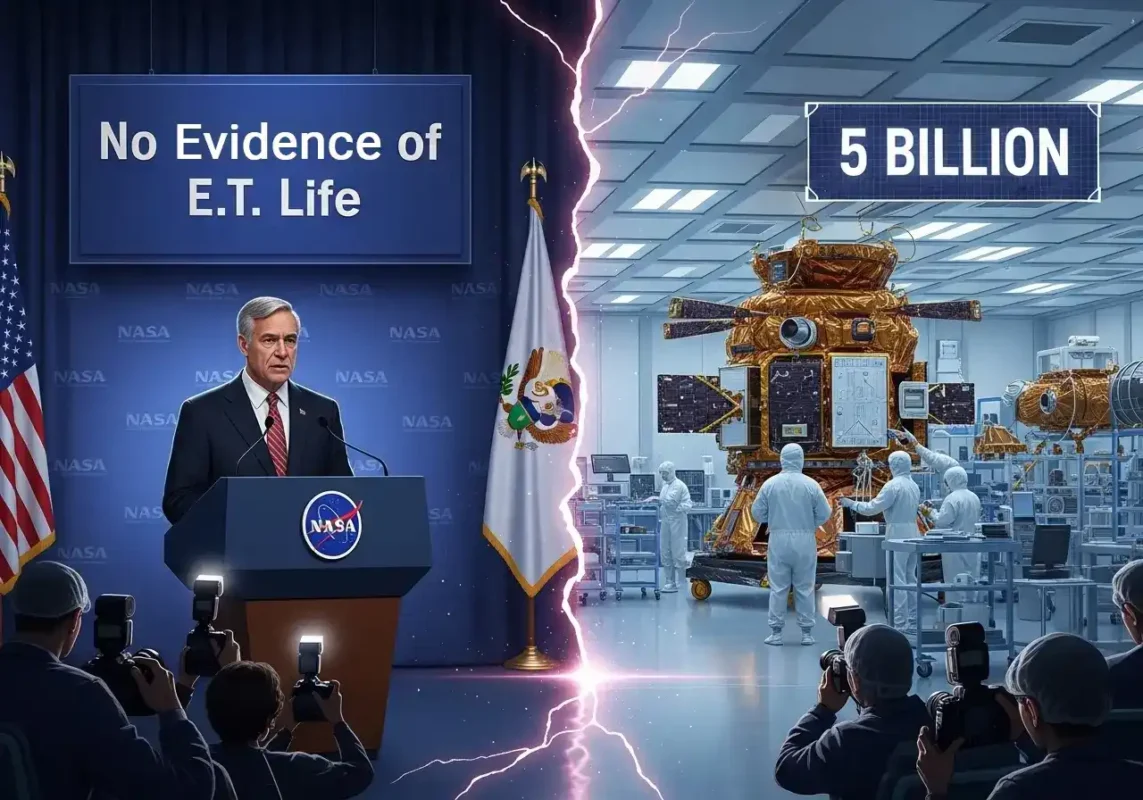
NASA paradox official statement vs budget art
Part I: Deconstructing “The Search” – Where the Billions Really Go
To solve the paradox, we must first understand that NASA is not conducting one monolithic “alien search.” It is running several distinct, parallel quests with different targets, methods, and probabilities of success. The billions are not being spent on listening for radio signals from “little green men.” They are being spent on a disciplined, scientific hunt for the most fundamental thing of all: life, in any form. This is the world of astrobiology.
Chapter 1: The Mars Offensive – A Hunt for Ancient Fossils
Mars is NASA’s primary battleground in the search for life. It is the most Earth-like planet in our solar system, and evidence suggests it was once a warm, wet world. NASA’s Mars program is not a single mission but a multi-decade, multi-billion dollar campaign to answer one question: Did life ever exist on the Red Planet?

Perseverance rover Jezero Crater panorama
The Current Fleet (as of June 2025):
- Curiosity Rover: Since 2012, Curiosity has been exploring Gale Crater. It has found definitive evidence of a past freshwater lake that was habitable for millions of years. It also detected complex organic molecules—the building blocks of life—and mysterious, seasonal plumes of methane gas, which on Earth is primarily produced by living organisms.
- Perseverance Rover: Landing in 2021, Perseverance is the most advanced astrobiology lab ever sent to another world. Its target is the Jezero Crater, the site of a 3.5-billion-year-old river delta, a perfect spot to preserve fossils. Its primary mission is to collect and cache rock samples.
The Crown Jewel: Mars Sample Return (MSR)
This is where the big money is. The MSR is a joint mission between NASA and the European Space Agency (ESA) to do something unprecedented: bring Martian rocks back to Earth for analysis.
- The Mission: A complex, multi-stage mission planned for the late 2020s and early 2030s. It involves sending a lander to retrieve the samples collected by Perseverance, launching them into Mars orbit with a small rocket (the Mars Ascent Vehicle), and having another orbiter capture the sample container and fly it back to Earth.
- The Cost: The estimated cost has ballooned, with internal reviews in 2024 placing it between $8 billion and $11 billion.
- The Justification: Why spend so much? Because laboratories on Earth are thousands of times more powerful and versatile than anything we can fit on a rover. A hypothetical NASA astrobiologist, Dr. Kenji Tanaka, explains it this way: “The instruments on Perseverance can tell us if a rock is interesting. The labs on Earth can tell us if it contains a 3.5-billion-year-old fossilized microbe. The MSR mission is our first, best chance to hold physical proof of alien life. It’s one of the most important scientific undertakings in history, and its price tag reflects that.”
So, when NASA spends billions on “Mars exploration,” a huge portion of that is a direct, targeted hunt for alien fossils. It’s a search for life, not necessarily intelligence.
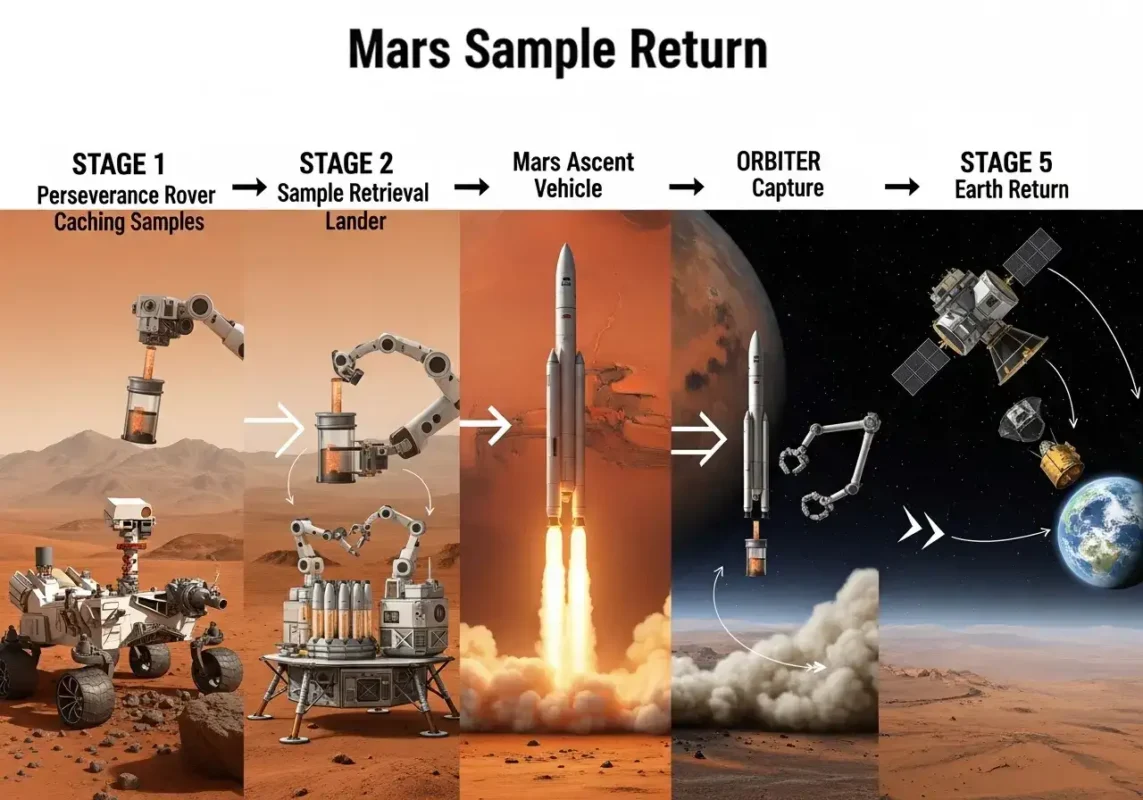
Mars Sample Return mission infographic
Chapter 2: The Ocean Worlds – Probing Under the Ice
Beyond Mars, the most exciting targets for life are the “ocean worlds”—icy moons in the outer solar system that hide vast, global oceans of liquid water.
Europa: Jupiter’s Prime Candidate
- The World: Europa is slightly smaller than Earth’s moon, but scientists believe its subsurface ocean contains more than twice the amount of water as all of Earth’s oceans combined. This ocean is salty and is kept warm by the tidal forces of Jupiter’s immense gravity.
- The Mission: Europa Clipper ($5 Billion): Launched in October 2024, the Europa Clipper is NASA’s flagship mission to the outer solar system. It will not land, but will perform dozens of close flybys of Europa, using a powerful suite of instruments:
- Radar: To measure the thickness of the ice shell and confirm the ocean’s depth.
- Spectrometers: To analyze the composition of the ice and any water plumes that may be erupting into space, searching for organic molecules.
- Magnetometer: To confirm the ocean’s salinity and characteristics.
- The Goal: The mission’s stated goal is to “investigate whether Europa has the potential for life.” It is a foundational step, scouting the moon to identify the best places for a future lander to search for life directly.
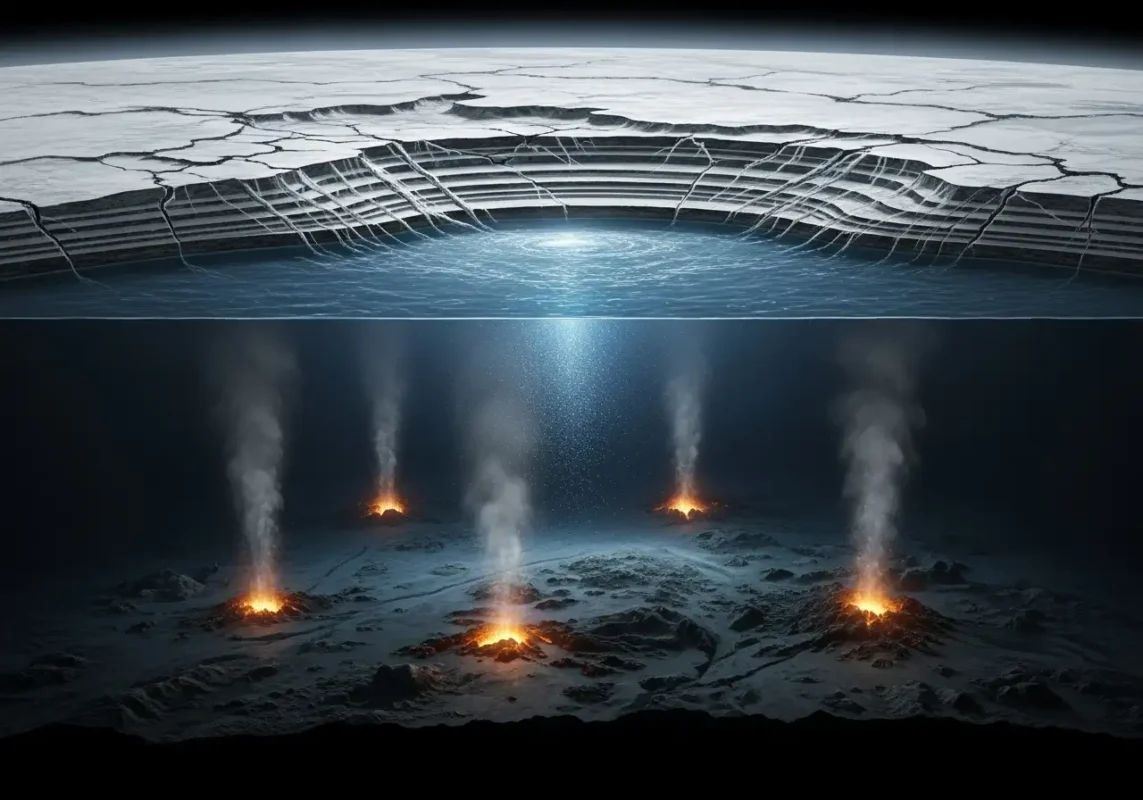
Europa subsurface ocean hydrothermal vents illustration
Enceladus: Saturn’s Dark Horse
- The World: This small moon of Saturn surprised everyone when the Cassini spacecraft discovered massive plumes of water vapor erupting from “tiger stripe” fissures in its southern polar region.
- The Evidence: Cassini flew through these plumes and its instruments detected not just water, but salt, silica (indicating hydrothermal activity), and a rich variety of complex organic molecules, including methane. A 2023 study confirmed the presence of hydrogen cyanide, a key molecule for the origin of amino acids.
- The 2025 Plan: The evidence from Enceladus is so compelling that by June 2025, the planetary science community is strongly advocating for a dedicated mission. The proposed “Enceladus Orbilander” would both orbit the moon and land near a plume to directly analyze the “ocean snow” for signs of life. While not yet funded, it is considered a top-priority mission for the next decade.
The multi-billion dollar investment in these missions is a clear indication that NASA is not just open to the idea of alien life—it is actively and aggressively hunting for it.
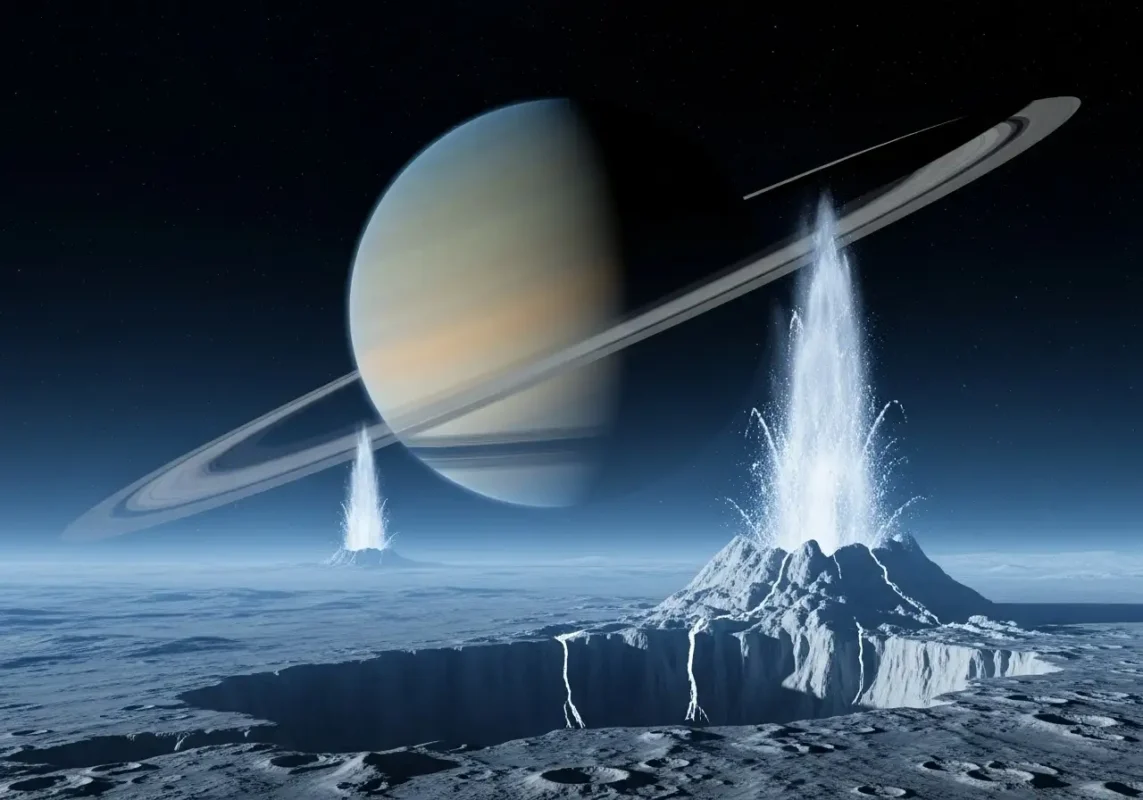
View from Enceladus surface Saturn art
Chapter 3: The Exoplanet Frontier – Sniffing Alien Atmospheres
The James Webb Space Telescope (JWST), operational since 2022, has given humanity a new superpower: the ability to analyze the atmospheres of planets orbiting other stars.
- The Method: Transit Spectroscopy: When an exoplanet passes in front of its star from our point of view, a tiny fraction of the starlight filters through the planet’s atmosphere. JWST’s incredibly sensitive instruments can capture this light and break it down into a spectrum. Different molecules in the atmosphere absorb light at specific wavelengths, leaving a unique “barcode” that tells us what the air is made of.
- The Search for Biosignatures: Scientists are looking for combinations of gases that are out of chemical equilibrium—gases that shouldn’t exist together without a constant biological source.
- The Holy Grail: The presence of both abundant oxygen and methane in the same atmosphere is a very strong biosignature. Oxygen is highly reactive and would quickly disappear unless something (like photosynthesis) is constantly replenishing it. Methane is also broken down by sunlight, so a biological source (like microbes) would be needed to maintain its levels.
- The 2025 Status: By mid-2025, JWST has successfully analyzed the atmospheres of several gas giants and is beginning to get its first good data from smaller, rocky, Earth-sized planets like those in the TRAPPIST-1 system. While no definitive biosignatures have been announced, the technology has been proven to work. A hypothetical JWST project scientist, Dr. Evelyn Reed, might state, “In 2025, we are at the dawn of a new era. We have the tool. It’s now a numbers game. We need to survey dozens, perhaps hundreds, of Earth-like worlds. Finding that first biosignature is likely a matter of ‘when,’ not ‘if.'”
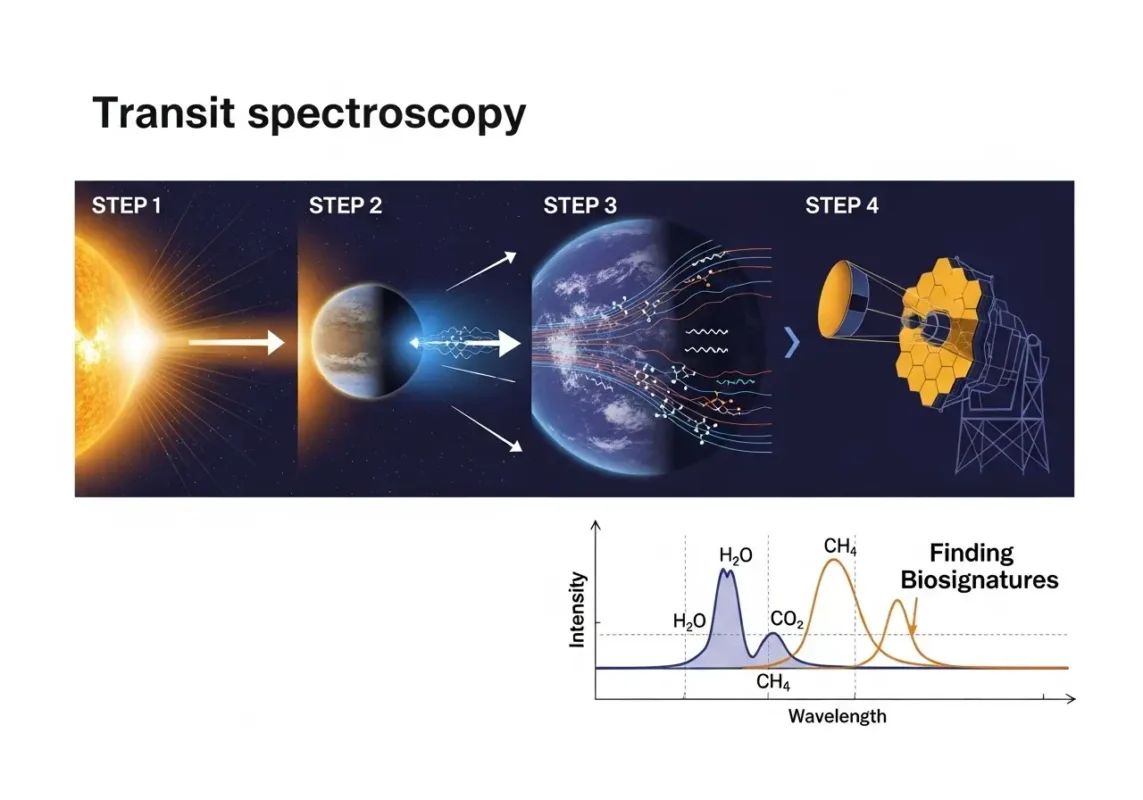
JWST transit spectroscopy infographic
Part II: Deconstructing “Fruitless” – The Search for
Now we address the other side of the paradox. When NASA says the search has been “fruitless,” they are almost always referring specifically to the search for technological alien life—intelligent beings with radios, lasers, or starships. This is a much harder, and historically, a much less funded, search.
Chapter 4: The Great Cosmic Haystack – The Challenge of SETI
The Search for Extraterrestrial Intelligence (SETI) is the discipline of listening for alien broadcasts.
- The Problem of Scale: The challenge is immense. SETI researchers must search across billions of star systems, across a huge range of radio frequencies, and at a specific moment in time. This has been compared to trying to find a single needle in a “cosmic haystack” the size of a galaxy.
- Funding History: For most of its history, SETI has received very little to no NASA funding. After a brief NASA program was canceled by Congress in 1993, the search has been carried on almost exclusively by private institutions, like the SETI Institute, funded by donors like Paul Allen.
- The “Wow!” Signal: The most famous potential success story in SETI history came in 1977, when the “Big Ear” radio telescope at Ohio State University detected a powerful, narrow-band radio signal coming from the direction of the constellation Sagittarius. Astronomer Jerry Ehman, who discovered the signal on a data printout, was so impressed he circled it and wrote “Wow!” beside it. The signal lasted for 72 seconds and was never detected again. It remains the most compelling candidate for an alien broadcast ever received.
So, from NASA’s official perspective, their direct search for intelligent signals has been minimal and, aside from tantalizing but unrepeatable signals like “Wow!”, it has indeed been fruitless.

Wow Signal printout recreation
Chapter 5: The Game-Changer – NASA’s Reluctant Dive into UAPs
For decades, NASA studiously avoided the topic of UFOs, considering it unscientific. That has all changed.
- The Congressional Mandate: Following the 2017 Pentagon revelations and the subsequent public hearings, Congress mandated that all parts of the U.S. government, including NASA, must take the issue of Unidentified Anomalous Phenomena (UAPs) seriously.
- NASA’s UAP Study Team: In 2022, NASA commissioned an independent study team to look at UAP data from a scientific perspective. They released their public report in September 2023.
- The Report’s Conclusion: The report stated that there was “no reason to conclude” that existing UAP sightings have an extraterrestrial source, but it also stressed that the data is poor and that the sightings represent a serious issue for air safety and national security.
- The Key Recommendation: The report’s main recommendation was for NASA to use its scientific expertise and satellite infrastructure to help collect better, more reliable data on UAPs.
- The 2025 Role: In response, NASA appointed a Director of UAP Research. As of mid-2025, NASA’s role is not to “hunt for alien ships,” but to act as a scientific consultant to the Pentagon’s All-domain Anomaly Resolution Office (AARO). Their job is to figure out how to use NASA’s existing Earth-observing satellites and scientific know-how to better characterize these objects, whatever they may be.
- The Official Justification: NASA Administrator Bill Nelson has repeatedly framed this as a science and safety issue. A typical public statement would be: “The NASA mission is to explore the unknown. We have some of the world’s best scientists and data analysts. If the Department of Defense has unexplained phenomena, it is our duty as a federal agency to apply our tools to that problem and see if we can help solve it. That’s what science does.”
This is a crucial distinction. NASA is not spending billions on UAP hunting. It is leveraging a tiny fraction of its existing resources to fulfill a government mandate to study a real-world data problem.
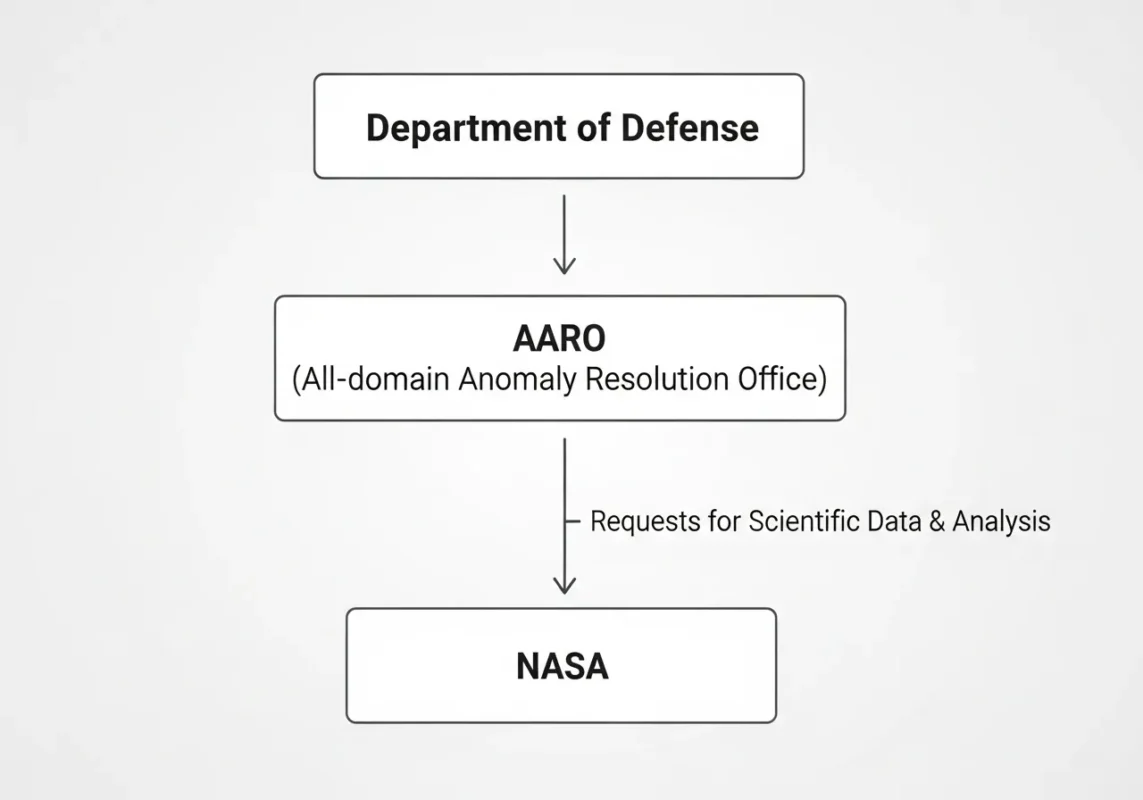
NASA AARO relationship organizational chart
Chapter 6: The Elephant in the Room – The Whistleblower’s Accusations
The official, cautious approach of NASA and the Pentagon was thrown into chaos by the testimony of whistleblower David Grusch in July 2023.
- The Claims: Grusch, a former high-level intelligence official, alleged under oath that the U.S. government has been running a secret, illegal UAP crash retrieval and reverse-engineering program for decades. He claimed to have been briefed by officials with direct knowledge of programs that possess “non-human” craft and “biologics.”
- The Impact on NASA: Grusch’s testimony creates a massive credibility problem for the official narrative. If he is telling the truth, then the public statements from NASA and the Pentagon that there is “no evidence” are, at best, misleading and, at worst, part of an active disinformation campaign.
- The Conspiratorial View: From this perspective, NASA’s public search for microbial life is a “benign distraction,” a multi-billion dollar piece of theater designed to keep the public and the scientific community looking at distant stars while the real secret—recovered alien technology—is managed in the shadows by the military-industrial complex. In this view, NASA’s leadership may not even be “in on it”; the real program is hidden within deeply compartmented special access programs (SAPs) that even the NASA administrator doesn’t have clearance for.

NASA public vs secret alien research
Part III: The Synthesis – Resolving the NASA Paradox
We have followed the money and dissected the rhetoric. It is time to resolve the paradox presented in our title. The reason NASA can invest billions in an “alien search” while claiming it is “fruitless” is because they are engaged in three separate and distinct searches, each with its own goals, budget, and public messaging.
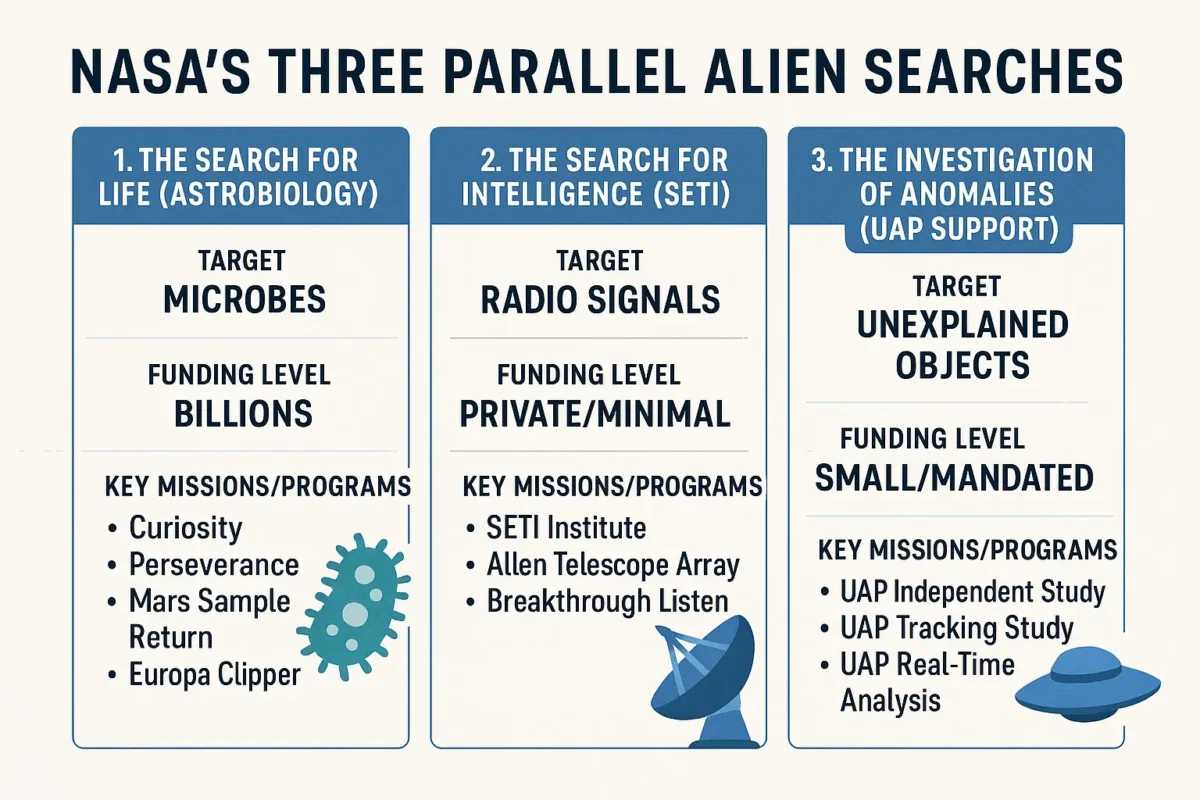
NASA three alien searches infographic
- The Search for LIFE (Astrobiology):
- Target: Microbial or fossilized life.
- Budget: Billions of dollars. This is where the vast majority of the “alien search” money goes.
- Public Stance: Open, proud, and optimistic. This is a core NASA science mission.
- Is it Fruitless? No. It is a foundational scientific quest that is making incredible progress.
- The Search for INTELLIGENCE (SETI):
- Target: Technological signals (radio, lasers).
- Budget: Essentially zero from NASA. Primarily privately funded.
- Public Stance: Supportive but distant. Acknowledges its scientific merit but does not fund it.
- Is it Fruitless? Yes, to date, this specific search has yielded no confirmed results, making the “fruitless” claim technically accurate in this context.
- The Investigation of ANOMALIES (UAP Support):
- Target: Unidentified objects in our atmosphere and space.
- Budget: Small and leveraged. No new “missions,” but using existing assets and personnel.
- Public Stance: Cautious, reluctant, and framed as a data science/air safety problem. This is a congressionally mandated task, not a proactive alien hunt.
- Is it Fruitless? The investigation has just begun. The official stance is that there is no evidence of an extraterrestrial origin yet.
The Verdict on the Paradox: There is no true paradox. The statement that the search for intelligent alien life has been fruitless is true from a historical SETI perspective. The investment of billions is for the search for microbial or fossilized life, which is a completely different and highly active field. The new UAP role is a separate, mandated investigation.
The perceived contradiction arises from lumping these three distinct efforts under the single, ambiguous term “alien search.” NASA’s public communications often fail to make these distinctions clear, and the explosive claims of whistleblowers suggest there may be a fourth, hidden category that a public-facing agency like NASA can never acknowledge.
Conclusion: A New Era of Inquiry
The question, “Why is NASA investing billions in an alien search they claim is fruitless?” leads us to a fascinating and complex truth. NASA is not being hypocritical; it is being compartmentalized. It is running a multi-pronged, multi-billion dollar astrobiology campaign with immense hope, while simultaneously fulfilling a reluctant mandate to scientifically analyze the UAP mystery that the Pentagon has handed it.
As we stand on the cusp of 2025, we are entering the most exciting era in the search for extraterrestrial life. The samples from Mars are being collected, the Europa Clipper is on its way, the JWST is staring into alien skies, and the U.S. government is being forced to confront the secrets in its own files. The silence may be broken not by a single “hello” from the stars, but by the slow, steady, and undeniable accumulation of data from all fronts. The search is anything but fruitless; it may be the most fruitful endeavor humanity has ever undertaken.
Join the Most Important Search in History
The questions are bigger than ever, and the potential for discovery is immense. At IHeartCryptids.com, we are committed to following every twist and turn of this incredible story.




Explore the Alien Phenomenon: From scientific explorers to mysterious visitors, our Alien collection has something for every believer and skeptic.
➡️ Shop the Official IHeartCryptids Alien Collection
Want to take your fascination with the unknown even further? Check out The Ultimate Alien & UFO Gifts Guide: 10+ Legendary Ideas for Believers — a handpicked collection of cosmic finds that every true fan will love.
The legend of the Alien is just one chapter in the world’s great book of mysteries. Your expedition has only just begun. Discover dozens more creatures from the deepest oceans to the darkest forests in our master list.
Continue your journey here: A Cryptozoologist’s Field Guide: The A-Z of 50+ Legendary Cryptids
Stay ahead of the curve. Be the first to know about the latest NASA findings, UAP disclosures, and scientific breakthroughs. Subscribe to the IHeartCryptids newsletter for the ultimate briefing on the unexplained.

